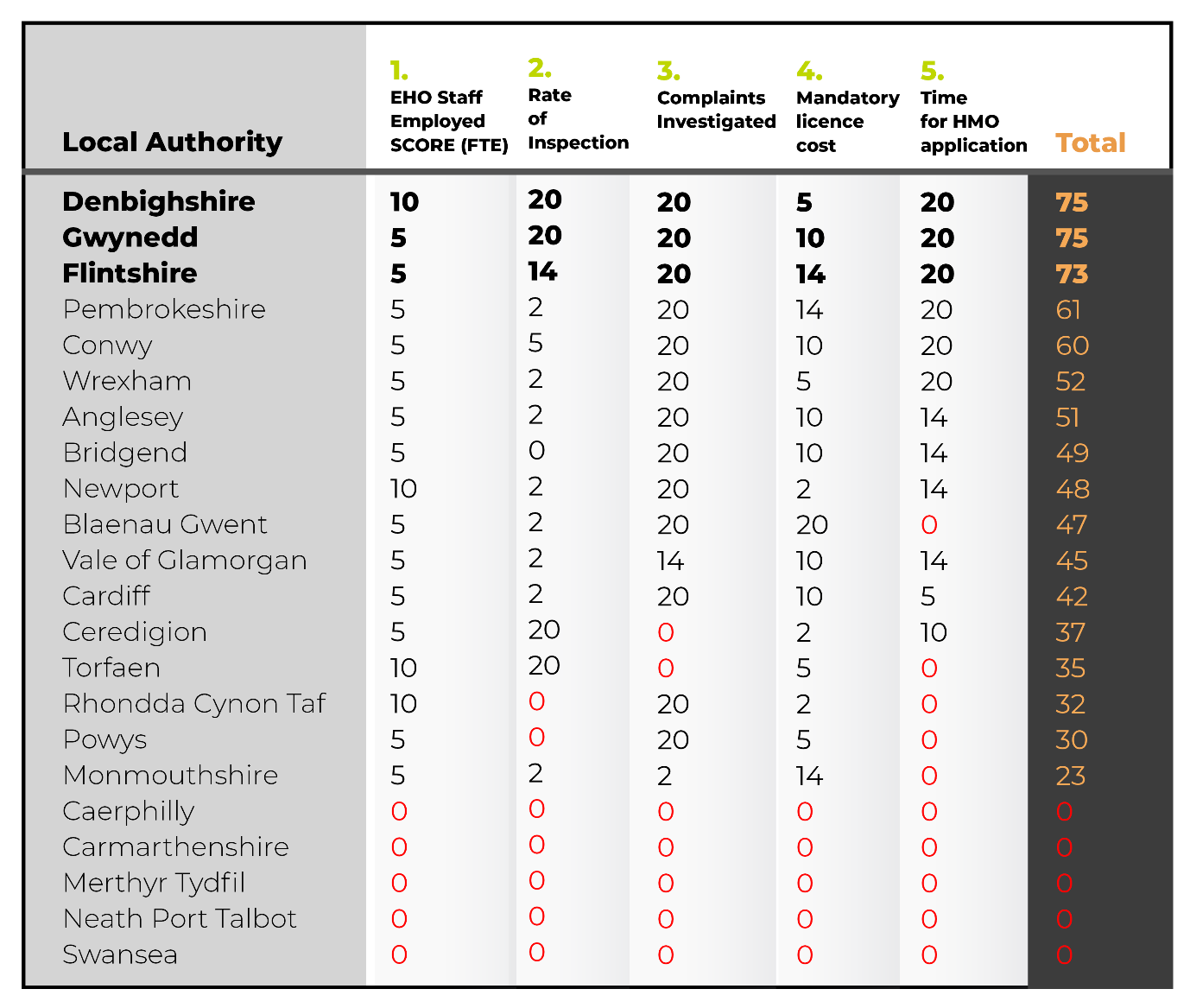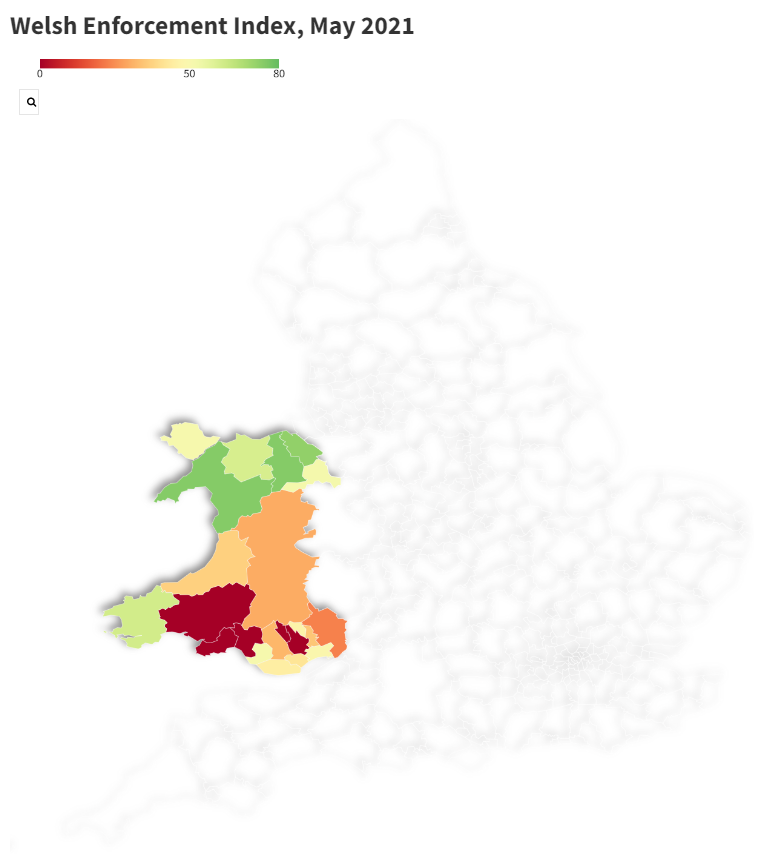

The Welsh Enforcement Index: The Persistence of Inconsistency
Welsh Enforcement Index Background
In late 2020, the NRLA (National Residential Landlords Association) Research Observatory began to collect data and evidence on how enforcement powers available to Welsh local authorities were being deployed in the Private Rented Sector (PRS). It is intended to be a follow-up to the NRLA’s recent review of Rent Smart Wales. The focus of this study was slanted towards mandatory and discretionary licensing, and the efficient, effective and economic enforcement of existing regulations.
Among the questions posed in this research:
- Are local authorities enforcing regulations in a consistent manner?
- Are resources which specifically address the PRS being applied between local authorities in a comparable manner?
- Can a link be made between enforcement and the experience of being either a tenant or landlord in the PRS.
This project looked to identify data collected in each Wales local authority to enable reasonable comparison. Further, to combine data collected in each local authority into a single league table of performance, independent of the size of each local authority. The league table provides an easy-to-understand comparison between local authorities.
League table analysis
Local authorities were asked a host of questions regarding their enforcement powers, the NRLA research observatory then subsequently used these questions to design five key metrics. Local authorities were assigned scores based on their performance in each of these metrics, these 5 scores were then combined to create an overall score. The league table ranks each local authorities enforcement powers by their overall score.
1. Staff employed
The first of these five metrics is the number of staff employed per properties in each local authority. It stands to reason that the amount of time and value of resources dedicated to the PRS gives an indication of the importance local authorities attach to enforcement. Authorities were asked how many Full Time Equivalent (FTE) staff members they had employed to handle PRS enforcement. The more staff the more points awarded.
2. Rate of inspection
A Stock Condition Survey is a detailed inspection of a property to determine the age and condition of each building element. It is a crucial component of intelligence about standards. If local authorities have conducted a Stock Condition Survey more recently, we can estimate that their information on the PRS in their area is more up to date. As such, loca authorities were asked when they last conducted a Stock Condition Survey. The more recent the report, the more points awarded.
3. Complaints investigated
The number of complaints a local authority receives regarding the standard, management, or condition of PRS housing provides a tenant-led measure of the quality of PRS housing. The number of complaints however does not necessarily measure the enforcement powers of Welsh local authorities. Local authorities were therefore asking the number of complaints investigated, local authorities investigating a higher percentage of complaints will receive more points.
4. Mandatory licence cost
The cost of a licence varies across local authorities throughout the country. This is a simple measure to determine how costly the process of obtaining a licence is for landlords. Local authorities were asked the cost of a mandatory HMO licence for a single property occupied by five people. The cheaper the licence the more points a local authority will be awarded, as their licence is more cost-efficient.
5. Time for HMO application
f local authorities take an especially long time to issue a licence, this could indicate a capacity issue such as understaffing or misdirection of resources. Along with cost, processing time provides a clear, easy to understand measure of efficiency and value. The shorter the timeframe in which a local authority can process a licence, the more points it will be awarded.

The main takeaway from the league table analysis was the lack of consistency from each local authority. Even the top performing local authorities scored poorly in at least on metric.
Denibighshire, Gwynedd and Flintshire emerged as the top performers from the league table. All scoring highly for rate of inspection, complaints investigated and licence processing time. The NRLA also conducted scatter plot analysis with other key metrics visualised onto graphs, in which Gwynedd and Flintshire continued to score highly, with Denbighshire's licence cost and numer of complaints per housing unit bringing its score down.
Monmouthshire attained the lowest score from the league table analysis, scoring poorly against every metric except licence cost. Though a few local authorities scored poorly in the league table, Ceredigion emerged as a clear poor performer from additional scatter plot analysis. A mandatory licence in Ceredigion costs £1200, taking 84 days to process.
The five local authorities scoring 0 points did not respond to multiple Freedom of Information requests. Non-response could be due to numerous factors indicating poor enforcement:
- A lack of access to key information.
- Performance not being monitored effectively.
- Decisions being made without evidence.
Geographical alignment
Below is a map of Welsh local authorities. Each local authorities' enforcement score as noted in the league table has been shaded a colour on a red to green, 0-100 scale. Local authorities attaining stronger scores shaded green and local authorities with weaker scores shaded red.

The map clearly shows some geographical alignnment in terms of enforcement powers, with local authorities in North Wales generally scoring more highly than those in the south. In fact, 6 out of the top 7 authorities in the league table are located in North Wales.
Local authorities in North Wales receiving more favourable scores may reflect collaboration in enforcement. In response to a recent FoI, the NRLA were informed there exists a “North Wales Tech Panel”, a group in which good practice is shared and responses to legislation are co-ordinated. A group like this for the entirety of Wales could see wholesale improvement.
Conclusions
The overall aim of the research is to see whether local authorities apply existing enforcement powers effectively or whether new powers of enforcement are needed. From the analysis it can be concluded:
- The data shows a lack of consistency from Welsh local authorities in enforcement. Each local authority performed poorly in at least one key metric.
- This research highlights a disjointed, variable approach (a postcode lottery) in the enforcement of licensing duties across Wales.
As the licensing authority for the entirety of Wales, the NRLA suggests Rent Smart Wales should act as a regulator. It should be independent from any one local authority, and be given a brief to address these inconsistencies, outline good practice and recommend service levels.
Read the full report here!
The Welsh Enforcement Index
The Welsh Enforcement Index

